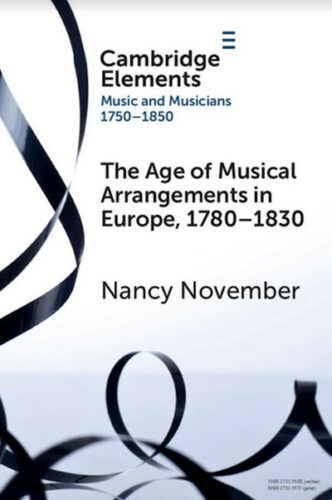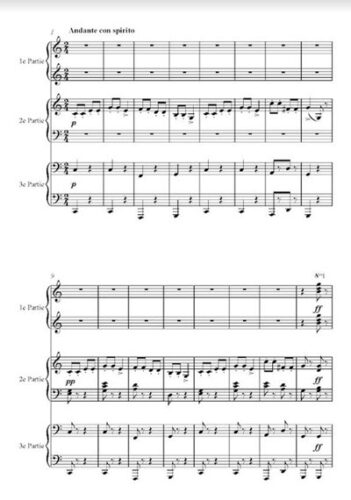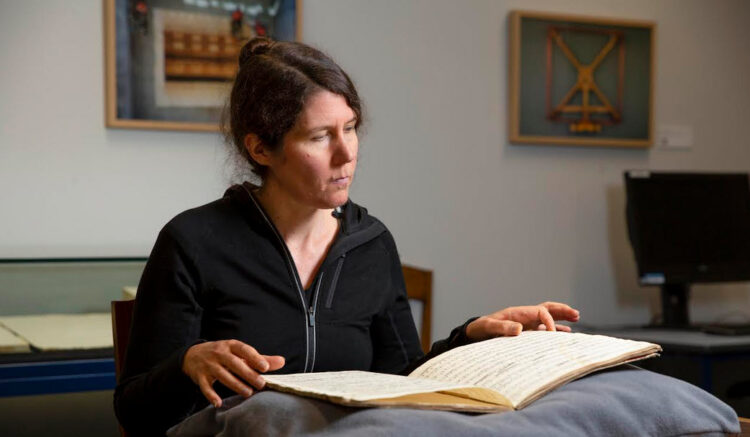by Mark Kroll
Published March 10, 2024
The Age of Musical Arrangements in Europe, 1750-1830. Nancy November. Cambridge Elements in Music and Musicians 1750-1850, Cambridge University Press. 80 pages.
The musical arrangement “deserves far more attention than it has thus far received.” Nancy November states this forcefully in the opening pages of her 80-page book on the subject, and she also explains why: “…we have missed the considerable cultural, musical and historical insight to be gained from studying and performing arrangements [and] the shaping effect of musical arrangements on the social, musical, and ideological landscape in that era.”

What, then, is this important musical genre? As with most questions in the arts, a simple or single answer can be elusive. In 1802, Heinrich Christoph Koch described arrangements as “translations of public or large-scale works for smaller scale ensembles,” but November reminds the reader that chamber works could also be “scaled up” (e.g., string quartets arranged as symphonies).
Perhaps a more generic definition would be that arrangements transfer musical material from one medium to another. That could encompass chamber ensemble arrangements of symphonies, orchestral versions of solo piano works, arrangements of arias from Mozart operas for two flutes or even a single guitar, and more. November provides the reader with a generous supply of tables and statistics to give a good sense of the large and ever-increasing number and variety of arrangements that appeared in publishers catalogues throughout European cities during what she calls a “crucial era for arrangements,” particularly 1780-1830. She also lists and describes publications by some of the more notable composers of arrangements from this period, such as Clementi and Hummel, each of whom, not incidentally, made a considerable amount of money for their efforts.
Terminology and statistics aside, the more important question is why musical arrangements became so popular during this time, and what roles did they play. The answer can be found in the artistic, economic, social and cultural changes that occurred during this period. These included the rise of an educated middle class and decline of the aristocratic monopoly on concerts and fine arts; the expansion in music publishing; and the growing number of amateurs playing music.

“Arrangements satisfied their want and need to re-hear and re-experience…public music in their homes,” November observes, thus giving them the opportunity “to relive the ‘surprise’ in the Andante of Haydn’s Symphony No. 94…in the privacy and comfort of home.” Moreover, arrangements helped this new educated class “delve into the complexities of…multilayered works, which went by all too fast on first listening.” It is therefore not surprising that the first miniature scores began to be published around the beginning of the century; some members of the audience reportedly brought and read these miniature scores at concerts.
The history of arrangements was dynamic, however, and the genre evolved as the century progressed, gradually separating into two categories: technically advanced (such as those by Hummel, Liszt and Wagner) “that are clearly for professional performance and also tend to take in more of the original,” and more basic arrangements designed for “amateur performance in the home.” Another development occurred after the 1830s, when the “variety of arrangement types, with piano chamber music occupying a central position” was replaced by arrangements “for piano alone or piano four-hands.” Indeed, this became the norm by the end of the nineteenth and throughout the twentieth century. Many music students of that bygone time will fondly remember the hours spent sitting at the piano with a colleague, enthusiastically banging out Beethoven symphonies in four-hand arrangements.
I might, however, mention just a few small quibbles in this excellent monograph. One is November’s decision to focus her attention on Haydn and Mozart, and the cities of Vienna and London. I understand the reasons for her decision, including the page limits of this series, but one might have wished for a more global approach, geographically and stylistically. I also think she is unnecessarily harsh in her judgment of certain extremes in the arrangement genre, such as calling orchestral arrangements of Bach organ toccatas “nonsense” (pace Leopold Stokowski) or condemning “preludes from the Well Temp. Clavier by [J.] S. Bach, arranged by patching in an obbligato cello part, ‘added’, of course, in the most modem way” (referring, I am guessing, to Ignaz Moscheles’ Studies in Melodious Counterpoint, op, 137a). These arrangements, and others like them, were made with the same sincerity and reverence for the originals as Salomon had for Haydn symphonies or Liszt for Beethoven’s. They, too, have their place in the musical world(s) of their times.
Such minor issues notwithstanding, this book is a welcome addition to Cambridge University Press’ Elements in Music and Musicians 1750-1850. CUP’s Elements is a very massive and still-growing series of short introductory books that the publisher describes as “original, succinct, authoritative, and peer-reviewed scholarly and scientific research” that are “conceived for a digital environment.” (Full disclosure: I am a contributor to this series.)

As Nancy November argues, a study of arrangements places “the everyday, the everyday people, and their everyday music back into music history…which in most of the literature has so far been focused on public events and lives and the ‘stately face’ of concert life.” She does so eloquently and convincingly.
Mark Kroll, a long-time advocate of musical arrangements, has written about the genre in EMA magazine, published articles on the subject in other journals (including a comparison of the arrangements of Beethoven symphonies by Hummel and Liszt), edited a number of editions of arrangements by Hummel, Avison and Geminiani, and performed and recorded the repertoire, (including a CD of Hummel’s chamber music arrangements of Mozart’s “Haffner” and “Linz” symphonies).




